
Huntingdonshire is a local government district in Cambridgeshire, England. It was historically a county in its own right. It borders Peterborough to the north, Fenland to the north-east, East Cambridgeshire to the east, South Cambridgeshire to the south-east, Central Bedfordshire and Bedford to the south-west, and North Northamptonshire to the west.
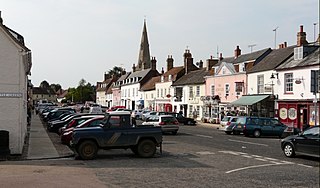
Kimbolton is a town and civil parish in the Huntingdonshire district of Cambridgeshire, England. Kimbolton is about 9 miles (14 km) west of Huntingdon and 14 miles (23 km) north of Bedford.

Chicheley Hall, Chicheley, Buckinghamshire, England is a country house built in the first quarter of the 18th century. The client was Sir John Chester, the main architect was Francis Smith of Warwick and the architectural style is Baroque. Later owners included David Beatty, 2nd Earl Beatty and the Royal Society. Chicheley Hall is a Grade I listed building.

Abbots Ripton is a village and civil parish in Cambridgeshire, England. Abbots Ripton is situated within Huntingdonshire which is a non-metropolitan district of Cambridgeshire as well as being an historic county of England. Abbots Ripton lies approximately 4 miles (6 km) north of Huntingdon on the B1090.

Toseland is a village and civil parish in Cambridgeshire, England. The name Toseland is Scandinavian and has connections to the Old Norse word 'lunde' translated as a type of sacred or small wood. The parish is neighbours with nearby parishes within Cambridgeshire such as Yelling, Gravely, Great Paxton and St Agnes.
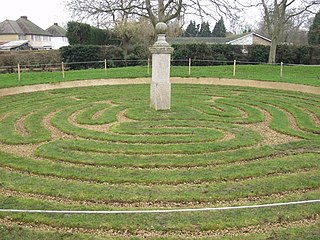
Hilton is a village and civil parish in Cambridgeshire, England. Hilton lies approximately 11 miles (18 km) north-west of Cambridge. Hilton is situated within Huntingdonshire, which is a non-metropolitan district of Cambridgeshire as well as being a historic county of England. The parish adjoins those of Elsworth, Fenstanton, Hemingford Abbots, Hemingford Grey, Papworth Everard and Papworth St Agnes. The Church of England parish church is dedicated to St Mary Magdalene and is a Grade I listed building; it has a peal of six bells. Historically, the village was in Huntingdonshire for over 1,000 years until 1974.

Wansford is a village straddling the City of Peterborough and Huntingdonshire districts in the ceremonial county of Cambridgeshire, England. It had a population of 506 at the 2021 Census. It is situated 7 miles (11 km) west of Peterborough and 8 miles (13 km) miles south of Stamford. It is close to the county boundary with both Lincolnshire and Northamptonshire. The village is also located close to the A1 road and was on the route of the original Great North Road before the modern A1 was built. The village has since been bypassed by the A1 but the former Great North Road still exists through the village.
William Alington, lord of the manor of both Bottisham and Horseheath, Cambridgeshire, was Speaker of the House of Commons of England, Treasurer of the Exchequer of Ireland, Treasurer of Normandy and High Sheriff of Cambridgeshire and Huntingdonshire.

Capesthorne Hall is a country house near the village of Siddington, Cheshire, England. The house and its private chapel were built in the early 18th century, replacing an earlier hall and chapel nearby. They were built to Neoclassical designs by William Smith and (probably) his son Francis. Later in the 18th century, the house was extended by the addition of an orangery and a drawing room. In the 1830s the house was remodelled by Edward Blore; the work included the addition of an extension and a frontage in Jacobean style, and joining the central block to the service wings. In about 1837 the orangery was replaced by a large conservatory designed by Joseph Paxton. In 1861 the main part of the house was virtually destroyed by fire. It was rebuilt by Anthony Salvin, who generally followed Blore's designs but made modifications to the front, rebuilt the back of the house in Jacobean style, and altered the interior. There were further alterations later in the 19th century, including remodelling of the Saloon. During the Second World War the hall was used by the Red Cross, but subsequent deterioration prompted a restoration.

Bramshill House, in Bramshill, northeast Hampshire, England, is one of the largest and most important Jacobean prodigy house mansions in England. It was built in the early 17th century by the 11th Baron Zouche of Harringworth but was partly destroyed by fire a few years later. The design shows the influence of the Italian Renaissance, which became popular in England during the late 16th century. The house was designated a Grade I listed building in 1952.

Crewe Hall is a Jacobean mansion located near Crewe Green, east of Crewe, in Cheshire, England. Described by Nikolaus Pevsner as one of the two finest Jacobean houses in Cheshire, it is listed at grade I. Built in 1615–36 for Sir Randolph Crewe, it was one of the county's largest houses in the 17th century, and was said to have "brought London into Cheshire".

Abbeystead House is a large country house to the east of the village of Abbeystead, Lancashire, England, some 12 km south-east of Lancaster. It is recorded in the National Heritage List for England as a designated Grade II listed building.
Sibson is a village in Cambridgeshire, England. Sibson lies approximately 6 miles (10 km) west of Peterborough city centre. Sibson is in the civil parish of Sibson-cum-Stibbington. Sibson is situated within Huntingdonshire which is a non-metropolitan district of Cambridgeshire as well as being a historic county of England. Sibson Aerodrome is 1 km south of the village.

There have been five baronetcies created for members of the old established family of Peyton of Peyton Hall in the parish of Boxford in Suffolk, all of whom were descended from Sir Robert Peyton of Isleham in Cambridgeshire, grandson and heir of Thomas Peyton (1418–1484) of Isleham, twice Sheriff of Cambridgeshire and Huntingdonshire, in 1443 and 1453. All the baronetcies are extinct.
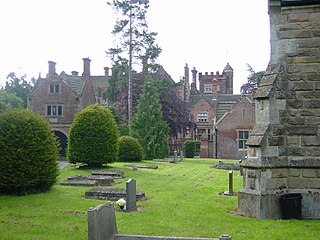
Shenton Hall is a country house within the village of Shenton, in Leicestershire, England. It is recorded in the National Heritage List for England as a designated Grade II* listed building.

Sir Thomas Proby, 1st Baronet of Elton Hall, Huntingdonshire was an English politician who sat in the House of Commons between 1660 and 1685.
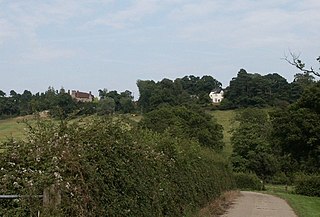
Holmshurst Manor is a Jacobean country house near Burwash in East Sussex, England. In 1970 it was purchased by Roger Daltrey of The Who.
Hilton Hall is an early 17th-century English country house in the village of Hilton in Cambridgeshire. The hall is listed Grade II* on the National Heritage List for England. The dovecote in the grounds of the hall is listed Grade II.

Edward Browning was an English architect working in Stamford.
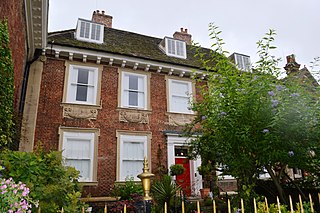
Walden House is a former municipal structure in Market Hill, Huntingdon, Cambridgeshire, England. The structure, which has formerly the headquarters of Huntingdonshire County Council and has since been converted into private apartments, is a Grade II* listed building.


















